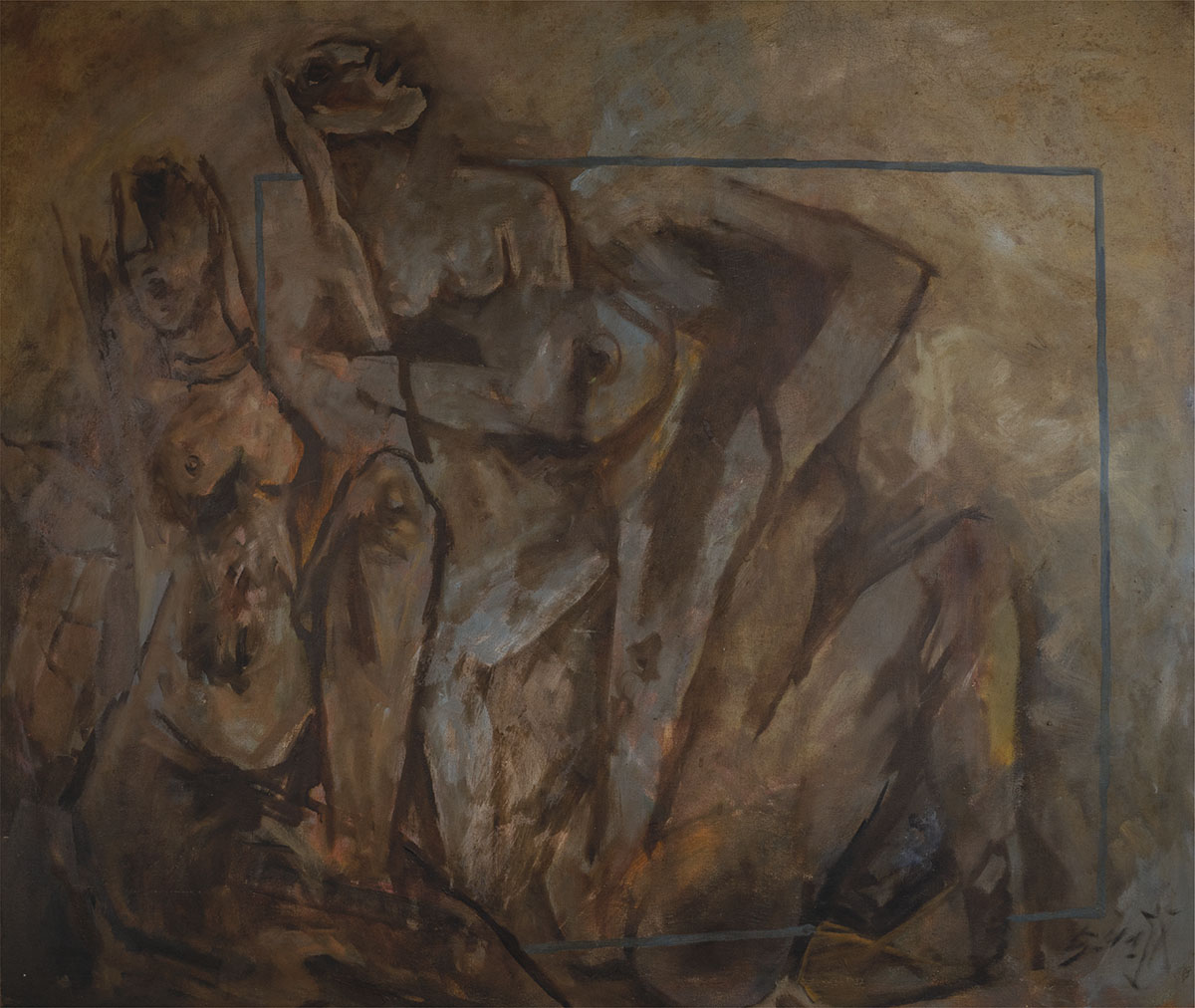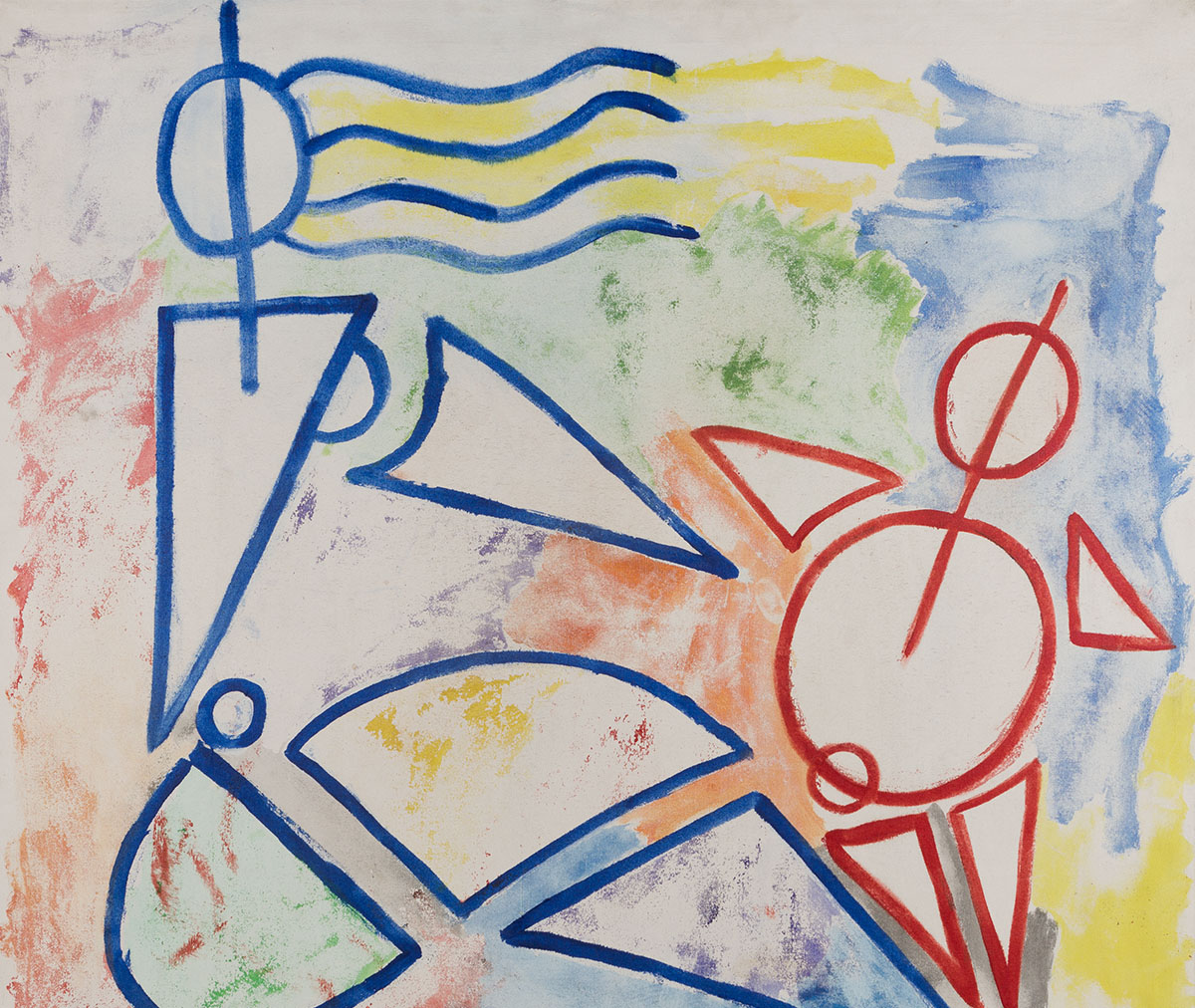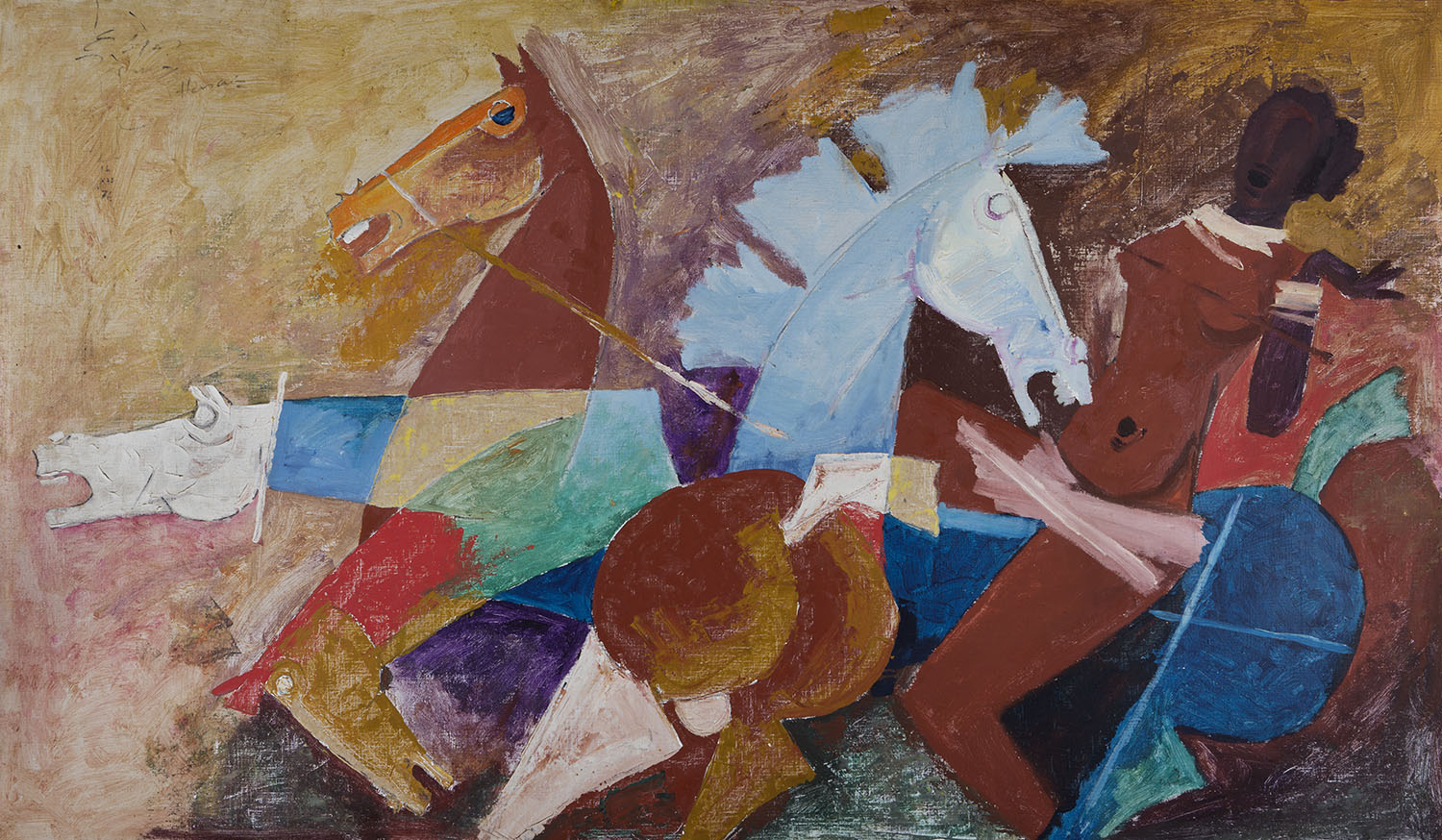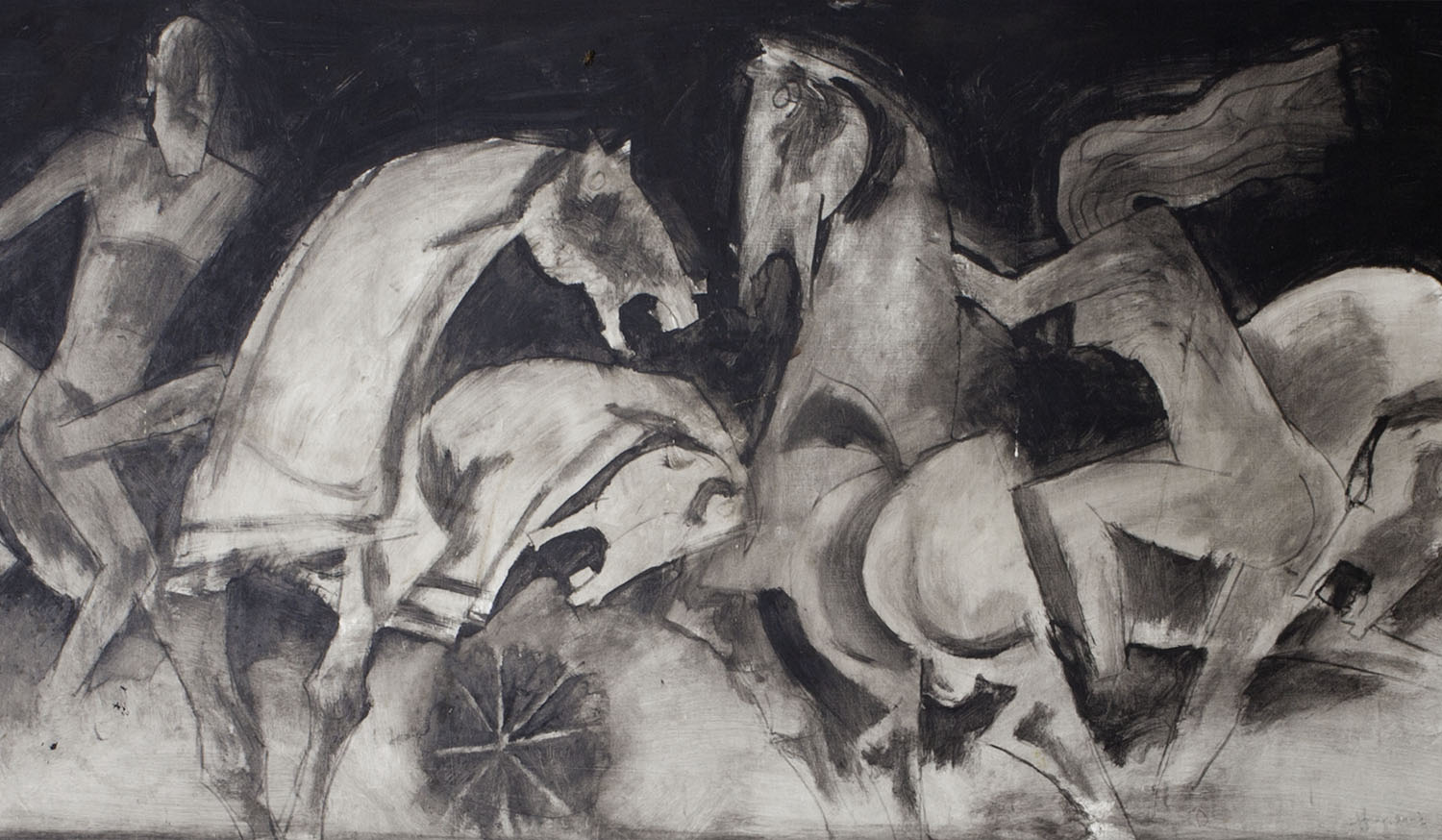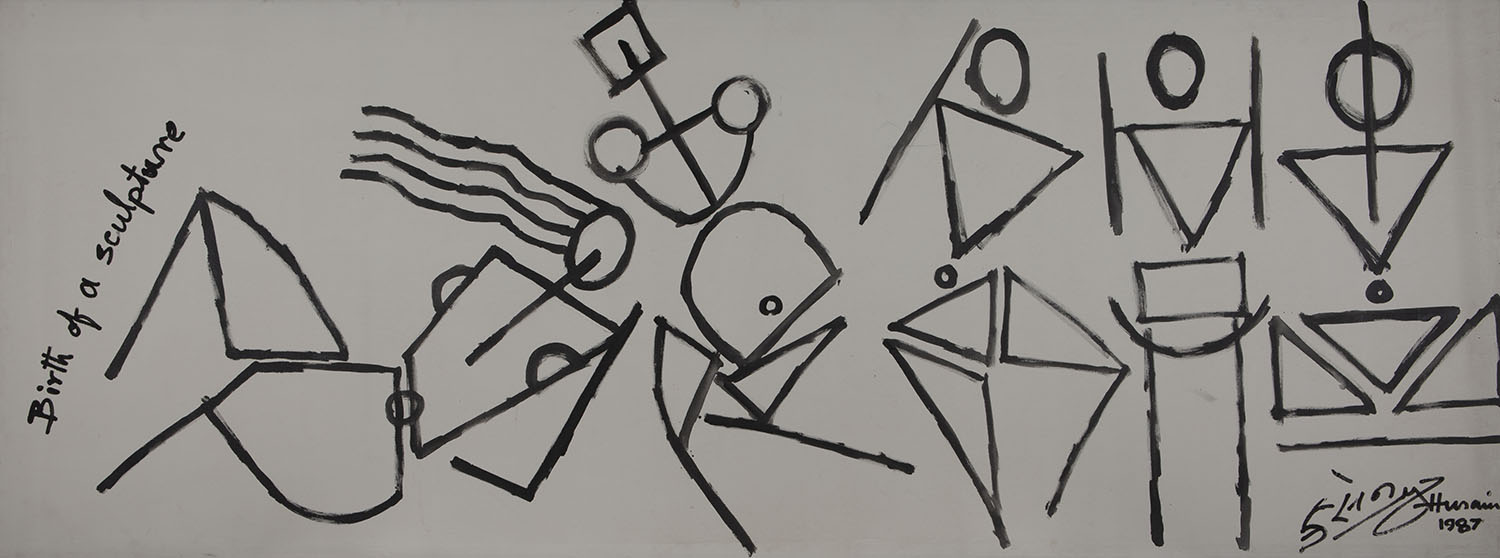ARTICLE
MF Husain
A Modernist artist and poet, Maqbool Fida Husain is one of twentieth-century India’s most widely known artists, recognised for his narrative paintings portraying subjects from popular culture, history and mythology in vivid colours and characteristically bold lines and forms. A founding member of the Bombay Progressive Artists’ Group (PAG), Husain adapted the Cubist style of European Modernist art to explore Indian themes, in oil, acrylic and watercolours, as well as offset printing and serigraphy. He is known for his public persona and prolific output, with a repertoire that also extended to filmmaking. Alongside his national and international success, Husain also encountered grave opposition from religious fundamentalists in India who considered some of his work to be offensive, and drove him to seek exile outside the country.
Born around 1915 in the Hindu temple town of Pandharpur, Maharashtra, Husain belonged to a working-class family in the small Sulaymani Bohra community of Muslims. The date of his birth was not recorded, and Husain is known to have assigned himself one later in life. After his mother died in his infancy, he was sent to his maternal grandfather’s madrassa in Siddhpur, Gujarat, to obtain religious instruction. It was here that Husain was exposed to Urdu language and literature; he developed his calligraphic skills, practising the Kufic script and designing calligraphic monograms, or tughra, using various mediums on paper. Later, growing up in Indore, Husain also absorbed Hindu mythology through folk traditions such as Ramlila performances, which enact scenes from the deity Rama’s life, and participated in the city’s spontaneous evening mushairas, or poetry recital contests. In 1932, Husain began attending evening classes in painting at the Government Institute of Fine Art, Indore, and made landscapes of the surrounding countryside in a style heavily influenced by the academic Naturalism taught in the college. In 1934, he enrolled at Sir JJ School of Art, Mumbai (then Bombay) to study painting, but financial constraints forced him to return to Pandharpur.
In 1937, Husain returned to Bombay, where he supported himself by painting billboards for Hindi films, an experience that familiarised him with creating large-scale figures quickly and decisively, and shaped his characteristic style. During this period, he also worked with a company that designed children’s furniture, while simultaneously painting, visiting exhibitions and occasionally participating in the city’s art shows. In 1947, Husain came into prominence by winning an award in the Bombay Art Society’s annual show. In the same year, he met the artists FN Souza, SK Bakre and SH Raza, and joined them in founding the PAG, which aimed at establishing a Modernist current in Indian art that was also globally relevant, through the amalgamation of pan-Indian artistic traditions and the techniques of European Modernism. He held his first solo exhibition in Mumbai in 1950. Unlike many other members of the PAG who emigrated abroad soon after, Husain remained in India until he was forced to leave in the 2000s.
Husain’s fascination with the country’s politics, history, mythology, people and cultures was reflected throughout his oeuvre, which portrayed a vast variety of Indian subjects and symbols. In the decade following the Partition and Independence Husain turned his attention to the pillars of independent India when he depicted the Indian countryside, village life, men and women farmers and motifs from rural life such as horses and wheels, seen in paintings such as Peasant Couple (1950), Zamin (1955) and Yatra (1955). In other works such as Amusement in the Street (1957) he combined his interest in Rajasthani miniature paintings with the bleak colours of contemporary and urban India. Husain, who had lost his mother at an early age, also remained preoccupied with the female form, whether ensconced in domesticity, in epics and the pantheon of India’s gods and goddesses, or as an erotic muse. In paintings such as Durga (1964) and Draupadi (1971) his subjects embody the concept of shakti or power associated with women in the Hindu canon. Another work, the Musicians (1961), portrays the Hindu god Krishna and two female forms, with the mythological snake Kundalini, whose uncoiled depiction stresses the erotic tension in the painting.
In the 1980s and 1990s, Husain created iconic images of cultural and political figures who were dominating the public imagination. After the success of Richard Attenborough’s film Gandhi (1982), he painted The Attenborough Panels (1983), a work made of six panels depicting MK Gandhi’s journey from his life in his ashram to his apotheosis as the mahatma, or great soul. He also made numerous paintings inspired by the Albanian missionary Mother Teresa, including the iconic Untitled (Mother Teresa) (1991), in which the nun is shown caring for an infant and a child, depicted only through her distinctive blue-trimmed white sari and a nurturing hand gesture — motifs that Husain repeatedly used to portray her, instead of defining her face. Individuals from contemporary popular culture — including politics, sport and film — continued to fascinate Husain, and were frequent subjects of his paintings over the decades.
Husain’s work, while secular in spirit, used symbolism and iconography drawn from religious and mythological sources, particularly the Mahabharata and Ramayana. In 2005, he painted The Last Supper, based on the mythologised event in the life of Jesus Christ, which was also interpreted as a comment on global poverty. Auctioned the same year, the work fetched a record price for an Indian painting at the time. In 2008, at the age of ninety-three, Husain embarked on a series of ninety-six paintings commissioned by Usha Mittal, wife of the industrialist Lakshmi Mittal. Titled Indian Civilization, the series would chart India’s history since antiquity. Husain was able to complete eight triptychs before his death, covering subjects ranging from political and cultural icons and deities to the varied cities, festivals, modes of transport, dances and domestic cultures of India.
With his active social and public life and a prolific output that went beyond the confines of galleries and collections, Husain became the most visible and recognisable Indian painter of the late twentieth and early twenty-first centuries. Besides producing several thousand paintings in his sixty-year career, he also created posters for India’s national airline, Air India; painted murals on restaurant walls; printed his work on textiles; and wrote and directed three films. The first of these, Through the Eyes of a Painter (1967), which featured iconographic elements from his paintings, received the Golden Bear short film award at the Berlin International Film Festival that year and the Indian National Award for Best Experimental Film in 1968. His subsequent films — Gaja Gamini (2000) and Meenaxi: A Tale of Three Cities (2004) centred on strong female protagonists, which were played by prominent Hindi film actresses Madhuri Dixit and Tabu respectively. Travelling extensively, he also frequently received media attention for acts such as painting in front of live audiences and painting on a human body. In 1986 he was made a member of the Rajya Sabha, the Upper House of the Indian parliament. Remaining detached from the actual proceedings of the house during his six-year tenure, he instead produced a series of black-and-white sketches based on his observations here. These were published as the book Sansad Upanishad: The Scriptures of Parliament in 1994.
However, as fundamentalist Hindu ideologies gained political force in the 1990s, Husain’s work began to receive criticism from groups who claimed that his nude depictions of Hindu goddesses such as Saraswati, Durga and Lakshmi hurt religious sentiments. These images — some of which were made as early as the 1970s — as well as a 2006 painting of a nude figure interpreted as Bharat Mata (Mother India), led to various lawsuits being filed against him. In 2004, Husain withdrew the film Meenaxi from theatres after a Muslim organisation, the All-India Ulema Council, criticised the use of Quranic verses in his lyrics for one of the film’s songs. Facing numerous legal cases accusing him of insulting religions and promoting enmity between different religious groups; repeated vandalism and violent threats; and government apathy, Husain was finally forced to leave India in 2006. He then lived in self-imposed exile between London and Doha until his death, having eventually given up his Indian citizenship to accept Qatari citizenship in 2010.
Husain received the National Award from the Lalit Kala Akademi, New Delhi in 1955; the Padma Shri in 1966; the Padma Bhushan in 1973; and the Padma Vibhushan in 1991. His works are part of the collections of the National Gallery of Modern Art, New Delhi; Los Angeles County Museum of Art; and the National Museum of Islamic Art, Doha.
Husain died in London in 2011, at the age of ninety-five.
Bibliography
Our website is currently undergoing maintenance and re-design, due to which we have had to take down some of our bibliographies. While these will be re-published shortly, you can request references for specific articles by writing to hellomapacademy@map-india.org.




